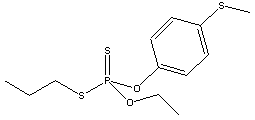Sulprofos
General
Type : Organophosphate,Insecticide,Sulfur Compound
Chemical_Nomenclature : ethoxy-(4-methylsulfanylphenoxy)-propylsulfanyl-sulfanylidene-$l^{5}-phosphane
Canonical SMILES : CCCSP(=S)(OCC)OC1=CC=C(C=C1)SC
InChI : InChI=1S\/C12H19O2PS3\/c1-4-10-18-15(16,13-5-2)14-11-6-8-12(17-3)9-7-11\/h6-9H,4-5,10H2,1-3H3
InChIKey : JXHJNEJVUNHLKO-UHFFFAOYSA-N
Other name(s) : Phosphorodithioic acid O-ethyl O-[4-(methylthio)phenyl] S-propyl ester,O-ethyl O-(4-(methylthio)phenyl) S-propyl phosphorodithioate,O-Ethyl O-[4-(methylthio)phenyl]phosphorodithioic acid S-propyl ester,O-Ethyl O-(4-methylthiophenyl) S-propyl dithiophosphate,Ethyl O-(4-(methylthio)phenyl) S-propyl phosphorodithioate,Bolstar(R),Bolstar 6,Heliothion Bolstar,Helothion,merdafo Morpafos
MW : 322.4
Formula : C12H19O2PS3
CAS_number : 35400-43-2
PubChem : 37125
UniChem : JXHJNEJVUNHLKO-UHFFFAOYSA-N
IUPHAR :
Wikipedia :

Target
References (6)
| Title : Subchronic neurotoxicity screening studies with six organophosphate insecticides: an assessment of behavior and morphology relative to cholinesterase inhibition - Sheets_1997_Fundam.Appl.Toxicol_35_101 |
| Author(s) : Sheets LP , Hamilton BF , Sangha GK , Thyssen JH |
| Ref : Fundamental & Applied Toxicology , 35 :101 , 1997 |
| Abstract : Sheets_1997_Fundam.Appl.Toxicol_35_101 |
| ESTHER : Sheets_1997_Fundam.Appl.Toxicol_35_101 |
| PubMedSearch : Sheets_1997_Fundam.Appl.Toxicol_35_101 |
| PubMedID: 9024678 |
| Title : [Chromatographic determination of Bolstar in soil, plants and water] - |
| Author(s) : Krasnykh AA , Shustov VS , Zelenina MF |
| Ref : Gig Sanit , 3 :53 , 1982 |
| PubMedID: 7084716 |
| Title : Effects of molasses, summer emulsifiable oil concentrate, crude cotton seed oil, and glycerin on the residual life of sulprofos on cotton - |
| Author(s) : Ware GW , Estesen BJ , Buck NA |
| Ref : Bulletin of Environmental Contamination & Toxicology , 28 :624 , 1982 |
| PubMedID: 6896466 |
| Title : Sister-chromatid exchanges and cell-cycle delay in Chinese hamster V79 cells treated with 9 organophosphorus compounds (8 pesticides and 1 defoliant) - Chen_1982_Mutat.Res_103_307 |
| Author(s) : Chen HH , Sirianni SR , Huang CC |
| Ref : Mutat Res , 103 :307 , 1982 |
| Abstract : Chen_1982_Mutat.Res_103_307 |
| ESTHER : Chen_1982_Mutat.Res_103_307 |
| PubMedSearch : Chen_1982_Mutat.Res_103_307 |
| PubMedID: 6211614 |
| Title : Dislodgable insecticide residues on cotton foliage: fenvalarate, permethrin, sulprofos, chlorpyrifos, methyl parathion, EPN, oxamyl, and profenofos - |
| Author(s) : Buck NA , Estesen BJ , Ware GW |
| Ref : Bulletin of Environmental Contamination & Toxicology , 24 :283 , 1980 |
| PubMedID: 6153915 |
| Title : Dislodgable insecticide residues on cotton foliage: permethrin, curacron, fenvalarate, sulprofos, decis, and endosulfan - |
| Author(s) : Estesen BJ , Buck NA , Ware GW |
| Ref : Bulletin of Environmental Contamination & Toxicology , 22 :245 , 1979 |
| PubMedID: 465782 |